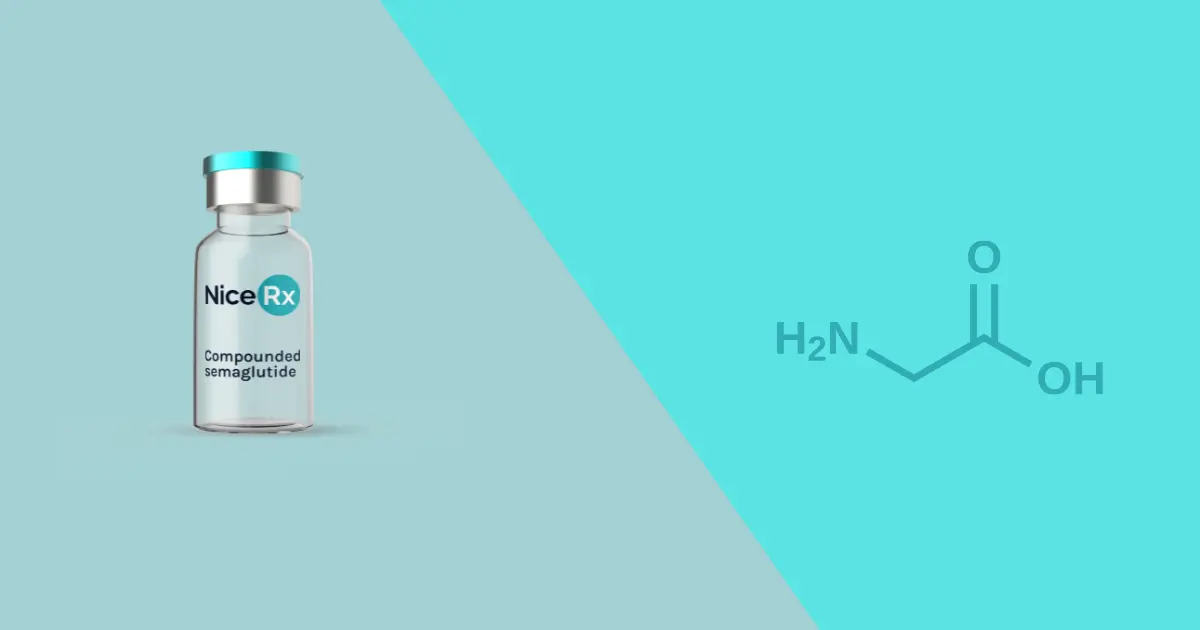Semaglutide with glycine: The complete guide
What if you could lose the fat without losing your muscle?
Key highlights
- Semaglutide with glycine is a compounded drug to promote weight reduction while potentially preserving lean muscle mass and enhancing overall metabolism.
- Semaglutide (brand-name Wegovy and Ozempic) is an FDA-approved GLP-1 receptor agonist used for weight management, treating weight-related complications, and improving glycemic control in patients with type 2 diabetes.
- Compounded semaglutide with glycine is a custom-made medication that is manufactured by compounding pharmacies. Glycine helps preserve muscle mass during weight loss, supports liver health, and improves metabolism.
- The combination of semaglutide with glycine is not FDA-approved. You should use it only if your healthcare provider prescribes it after a medical evaluation.
- Like other GLP-1 medications, compounded semaglutide with glycine is contraindicated for patients with a history of medullary thyroid carcinoma, MEN2 (multiple endocrine neoplasia type 2) syndrome, pancreatitis, and gallbladder issues.
- Always purchase compounded semaglutide with glycine from a reputable and licensed compounding pharmacy or a service provider that requires a valid prescription from a healthcare provider.
Semaglutide is a GLP-1 medication that mimics the action of the naturally occurring glucagon-like peptide-1 hormone to suppress appetite, increase insulin secretion, decrease hunger cravings, and reduce calorie intake. Reduced appetite and decreased calorie intake with semaglutide can lead to significant weight reduction.
Semaglutide (Wegovy and Ozempic) is FDA-approved for managing blood sugar levels in patients with type 2 diabetes mellitus and promoting weight loss in obese and overweight patients with at least one weight-related health condition, when used along with lifestyle changes such as a low-calorie diet and increased physical activity. According to research studies, semaglutide (Wegovy) reduces 10-15% of body weight when used for long periods.
However, rapid weight loss with semaglutide can lead to loss of lean muscle mass. To combat this issue, glycine is added to semaglutide to potentially preserve lean muscle mass, improve metabolism, and support liver health. Additionally, glycine acts as a pharmaceutical stabilizing agent in semaglutide preparation to maintain its integrity, stability, and pH.
This guide will explain how the combination of semaglutide and glycine works, why glycine is used, analyze the safety and efficacy of compounded semaglutide, and provide a roadmap for those considering it.
What is compounded semaglutide?
Drug compounding is the process of creating a customized medication, performed by a licensed pharmacist or healthcare provider to meet a specific patient’s needs.
Compounded semaglutide is a customized version of semaglutide that may contain extra ingredients such as vitamin B6, vitamin B12, or glycine. The U.S. Food and Drug Administration (FDA) allowed compounding semaglutide during the shortage of Ozempic and Wegovy. However, brand-name medications are currently available, and compounding is only allowed when the patient needs a customized dosage or formulation that is not commercially available.
It is important to remember that compounded semaglutide is not the same as the brand-name medications Ozempic and Wegovy. The compounded medication is not approved by the FDA, and its quality and efficacy depend on the standard of compounding pharmacies. Purchasing a compounded medication requires a valid prescription from a licensed healthcare provider.
Understanding the potential of glycine with semaglutide
Semaglutide is compounded with glycine to potentially preserve lean muscle mass in patients using the medication for weight loss.
What is glycine?
Glycine is a conditionally essential amino acid that supports protein synthesis and glutathione production in the body. This naturally occurring amino acid is used safely in many medications and supplements. Glycine is a precursor of glutathione, which is a powerful antioxidant to protect your body against free radicals and oxidative stress. It also forms collagen in the skin, reduces insulin resistance, protects cardiovascular health, and improves sleep quality.
Besides glycine, vitamin B12 (Cyanocobalamin) can also be added to semaglutide and may prevent nausea and fatigue.
The risk of losing lean mass on GLP-1 therapy
Semaglutide can be an effective injectable medication for weight loss when used along with dietary modifications and exercise. Dietitians usually recommend diet plans that focus on calorie restriction to promote weight reduction. Reduced calorie intake creates a calorie deficit, which not only metabolizes stored fats to promote fat loss but also muscle tissues to meet the protein needs of the body. If you do not take a protein-rich diet or your body is unable to meet protein needs, rapid weight loss with semaglutide may lead to loss of lean muscle mass.
Preserving muscle mass is crucial for maintaining metabolic health and weight stability. Certain muscles, such as skeletal muscles, are metabolically active and contribute to a major part of resting energy expenditure. If you lose muscle mass, it may decrease your body’s basal metabolic rate. Reduced basal metabolic rate can cause weight regain.
Additionally, muscles play an essential role in glucose reuptake, insulin sensitivity, strength, mobility, and physical functions. This is why it is crucial to preserve muscles while taking semaglutide.
Why glycine?
Research studies suggest that glycine may prevent lean muscle loss during a weight loss journey. This amino acid supports collagen production, repairs and maintains muscle proteins, and regulates anti-inflammatory pathways to protect muscle tissues. When added to semaglutide, it may prevent the loss of lean muscle mass in the body associated with rapid weight loss.
Glycine may offer the following benefits:
- It may preserve muscle mass by promoting tissue repair and synthesis.
- This amino acid reduces muscle breakdown by producing glutathione, which protects muscles from oxidative stress and reduces inflammation.
- It may support muscle recovery during weight loss.
The pharmaceutical purpose
Pure semaglutide may not be stable enough on its own. It may be mixed with a substance known as a buffering agent or excipient to maintain its stability, purity, and the correct pH for storage and administration.
Glycine acts as a “buffering agent” or “excipient” that helps stabilize the peptide structure, preserve its purity and integrity during storage and use, and maintain pH levels to protect the medication from degradation.
Glycine is a safe and well-tolerated excipient for most patients.
The core claims of semaglutide with glycine
Although theoretical data show promising results for glycine, no clinical trials have been conducted for this specific compound to confirm its benefits. These claims are anecdotal and may not be substantiated with clinical evidence.
Claim 1: Muscle preservation
Glycine supports Muscle Protein Synthesis (MPS) and protects muscle cells from degradation. Theoretically, these mechanisms contribute to better body composition and reduced muscle loss during weight loss.
Claim 2: Enhanced metabolism
Semaglutide increases insulin secretion, while glycine may improve insulin sensitivity and support liver function. It helps regulate glucose metabolism and allows glucose to move into the cells more efficiently. Moreover, glycine prevents insulin resistance, which is a major risk factor for metabolic disorders like type 2 diabetes.
Glycine also contributes to detoxification and nutrient breakdown. It helps your liver process fats and remove harmful substances, which promotes better metabolic control and energy production.
Compounded semaglutide with glycine vs. brand-name semaglutide
Semaglutide with glycine is a compounded medication that is not approved by the FDA. This means its production is not regulated or reviewed by the U.S. Food and Drug Administration (FDA). Compounding is the practice of dispensing customized medications in pharmacies to meet patients’ medical needs. Compounding is allowed only when the FDA-approved product is unavailable or when a patient has a specific medical need. For example, if you are allergic to an inactive ingredient of semaglutide, you can get an allergen-free medication dispensed from a compounding pharmacy.
Ozempic and Wegovy are brand-name medications that are approved by the FDA and are not the same as the compounded medication. Ozempic is indicated for managing type 2 diabetes, preventing kidney failure or worsening kidney disease in patients with chronic kidney disease and type 2 diabetes, and lowering the risk of cardiovascular events in patients with or without diabetes. Wegovy is FDA-approved for weight management in obese and overweight patients with at least one health condition that results from being overweight. These brand-name medications have undergone rigorous testing in clinical trials to review their safety, efficacy, and purity.
Although compounded semaglutide and brand-name medications of semaglutide contain the same active ingredient, compounded medications are not approved by the FDA for their safety and efficacy. The FDA has issued a warning that compounded semaglutide may contain salt forms of semaglutide, such as semaglutide sodium or semaglutide acetate, instead of semaglutide base used in Ozempic and Wegovy.
As compounded semaglutide is manufactured in compounding pharmacies, its quality varies among pharmacies, depending on the standard of the compounding pharmacy. An unregulated supply chain can result in the production of fraudulent products, medication containing incorrect ingredients, or products with either too high or too low potency, leading to inconsistent results and danger.
Safety, efficacy, and potential risks
Compounded semaglutide has its own pros and cons, which are summarized below.
Expected efficacy and side effects
Common side effects of semaglutide with glycine may include nausea, diarrhea, constipation, abdominal discomfort, and heartburn. These are typically transient and subside over time. Rare side effects are hypoglycemia, pancreatitis, diabetic retinopathy, gall bladder problems, gastroparesis (due to slowed gastric emptying), and increased risk of aspiration during sedation and anesthesia.
The efficacy of compounded semaglutide depends on its authenticity. The medication may have the same efficacy if you purchase it from reputable and licensed pharmacies. However, if you consume low-quality and unauthentic products, the results might not be the same.
High risk of dosing errors and overdoses
There might be high chances of dosing errors with compounded semaglutide injections, as the medication is typically available in the form of generic vials instead of pre-filled injections. Brand-name medications have pre-filled injections (for subcutaneous use) with measurements in milliliters (mL) or milligrams (mg). Vials of compounded semaglutide may have variable concentrations, and syringes marked in ambiguous “units.” It increases the risk of dosing errors. Overdosing may cause severe gastrointestinal side effects such as severe nausea, vomiting, hypoglycemia, and hospitalization due to the long half-life of semaglutide. Underdosing may not bring desired results.
Additionally, compounded medications can cause an injection site reaction if they are contaminated with infectious agents.
Risks with pharmacy quality
The choice of compounding pharmacy is the most critical step in purchasing compounded medications. The primary risk with any compounded drug is the quality control of the pharmacy producing it.
Always purchase compounded medications from licensed and reliable pharmacies. Avoid buying from online websites that do not require a valid prescription from a healthcare provider, as their products may be illegal and dangerous. Additionally, there is also the risk of contamination or improper dosing if the pharmacy is not reputable.
The following are red flags that indicate compounded semaglutide is not legitimate:
- The pharmacy does not require a valid prescription from a licensed healthcare provider might not be reliable.
- Pharmacies not registered with PCAB (Pharmacy Compounding Accreditation Board) or licensed by your state are not legitimate.
- If the pharmacy is selling products without labeling, do not purchase the medication.
- If the products are labelled as “for research purposes only”, or “not for humans”, do not purchase them, as they may have unknown or harmful ingredients.
- Online sellers with no contact information, address, or certifications.
Standard GLP-1 contraindications still apply
Compounded semaglutide has safety risks and contraindications to consider:
- Semaglutide is not indicated for patients with a personal or family history of thyroid tumors, particularly medullary thyroid carcinoma (MTC) and neuroendocrine tumors such as MEN 2 (multiple endocrine neoplasia) type 2 syndrome. Although human studies have not shown any association between GLP-1 medications and increased risk of cancer, these contraindications are based on results from rodent studies.
- If you have a preexisting history of pancreatitis (inflammation of the pancreas) or severe gallbladder issues (including cholecystitis and cholelithiasis), the medication is not suitable for you. Moreover, if you are on semaglutide therapy, closely watch for symptoms of pancreatitis (abdominal pain radiating to the back, fever, nausea, and vomiting). Stop taking the medication if you experience these symptoms and immediately consult your doctor.
- Semaglutide cannot be used in children, pregnant women, or breastfeeding women. If you are planning to conceive, stop taking semaglutide at least two months prior to planning.
- If you have a history of allergic or hypersensitivity reactions from any ingredient of semaglutide or glycine, you should not use this combination, as it may trigger hypersensitivity reactions again.
- Inform your doctor in case of diabetic retinopathy, as semaglutide may cause blurred vision or worsening of diabetic retinopathy. If you are already using semaglutide, get your vision evaluated by an ophthalmologist regularly to prevent vision changes.
How to identify a reputable source
Identify a reputable source by verifying the credentials of a compounding pharmacy. Here is a quick checklist:
- Is compounded semaglutide with glycine prescribed after a real consultation with a licensed U.S. provider?
- Has the doctor assessed your medical reports and history?
- Is the compounding pharmacy licensed by your state?
- Is a compounding pharmacy regulated by PCAB (Pharmacy Compounding Accreditation Board) or the FDA?
- Do they provide third-party testing for purity, potency, and sterility?
- Are they transparent about their ingredients and sourcing?
- Is the medication properly stored and sealed?
Is semaglutide with glycine right for you?
The medical criteria for compounded semaglutide with glycine are at the discretion of the medical provider, who will determine if the compounded medication is clinically appropriate. You may be eligible for the medication if you want to lose weight and you have:
- Obesity (Body mass index 30 or more)
- Overweight (BMI 27 or more) with at least one weight-related comorbidity such as hypertension (high blood pressure), hyperlipidemia, hypercholesterolemia (high cholesterol levels), or heart disease.
Here is a step-by-step process for getting a prescription from a telehealth provider:
- You will need to fill out a questionnaire requiring your information, such as body weight, height, BMI, blood sugar levels, and presence of comorbid conditions.
- If you meet the eligibility criteria for GLP-1 medications, you will get an appointment for an online consultation.
- During consultation, your doctor will check your previous medical records and take a detailed history to assess your suitability for treatment.
- Afterwards, your doctor will send a valid prescription to the pharmacy, which will prepare and ship the medications to your doorstep.
- You will need follow-up sessions with your doctor for dose adjustments, management of side effects, continuous care, and monitoring.
An alternative approach to muscle preservation on GLP-1 therapy
Lifestyle modifications can be an alternative approach to preserving muscles while taking weight loss medications.
No supplements or additives can replace a healthy lifestyle built on a balanced diet and exercise. When taking semaglutide or any other GLP-1 medications for weight loss, maintain your lean muscle mass by following these tips:
Adequate protein intake
A high-protein diet is the most effective and safest way to preserve muscle mass. Proteins are made up of amino acids, which play a critical role in the repair and maintenance of body muscles during weight loss.
Add protein-rich foods such as legumes, eggs, lentils, fish, white chicken, lean meat, tofu, Greek yogurt, and peas to your diet plan to ensure you meet your protein requirements daily.
According to the FDA, a healthy adult needs approximately 50 grams of protein per day. In older adults, the daily protein requirements are 1 to 1.2 grams per kg of body weight.
Resistance training
Your body maintains muscle tissues when you use them regularly. A sedentary lifestyle, along with semaglutide therapy, can lead to loss of muscle mass. Light resistance training, such as weight lifting and resistance bands, can help you maintain muscle mass naturally. During exercise, your body signals your brain to retain those muscles. Keep yourself engaged in strength training and regular exercise, and follow a protein-rich diet for the best results.
Glycine as an OTC supplement
If you are concerned about muscle loss due to rapid weight loss with semaglutide, you may be able to use glycine supplementation as a separate, over-the-counter (OTC) product after consulting with your doctor.
However, do not start any supplement on your own. Consult with your doctor to discuss whether this combination is suitable for you.
Frequently asked questions
Is semaglutide with glycine the same as Ozempic?
No, semaglutide with glycine is not the same as Ozempic. Although both contain the same active ingredient, semaglutide with glycine is prepared differently by compounding pharmacies and is not the brand-name or FDA-approved product. In comparison, Ozempic is a brand-name medication manufactured by Eli Lilly and is approved by the FDA.
Is it safe to buy semaglutide with glycine online?
Semaglutide with glycine may only be safe if you purchase it from a service that includes a consultation with a licensed U.S. healthcare provider who prescribes it, which is then fulfilled by a licensed, reputable compounding pharmacy. If you buy it from online websites or forums that do not require a prescription, it might not be authentic or safe.
Why is compounded semaglutide with glycine cheaper?
Compounded semaglutide with glycine is cheaper, but this combination is prepared in compounding pharmacies. The medication does not have the same R&D, marketing, and brand-name markup costs as brand-name medications. As it is not approved by the FDA, compounded semaglutide is a cash-pay product that bypasses the complex insurance billing.
What are the contraindications for compounded semaglutide?
The medication is not suitable for patients with a personal or family history of medullary thyroid carcinoma (MTC), MEN 2 syndrome (multiple endocrine neoplasia type 2 syndrome), or pancreatitis. Additionally, compounded semaglutide is contraindicated for females who are pregnant, breastfeeding, or planning to conceive.
Conclusion: Is semaglutide with glycine right for you?
Semaglutide with glycine is a powerful combination that may help preserve lean muscle mass during weight management, when used in combination with lifestyle modifications such as healthy eating habits and exercise. This compounded version can be a more accessible option for those who want to prevent muscle loss. However, the choice of compounding pharmacy is a critical factor that determines the safety and quality of the medication.
The combination of semaglutide and glycine is not approved by the FDA. The quality of compounded semaglutide depends on the standard of the compounding pharmacy. Always choose a reputable pharmacy or a telehealth service that offers the medication after consultation with a licensed healthcare provider. If you are considering this path, your mission is not just to find semaglutide, but to find a trusted, transparent medical provider and pharmacy that can verify its quality and safety standards.
Consult a licensed healthcare provider before starting compounded semaglutide with glycine to discuss whether this combination is safe for you. Prepare yourself with the questions provided in this guide, and take the next step with confidence and caution to achieve your weight loss goals.






